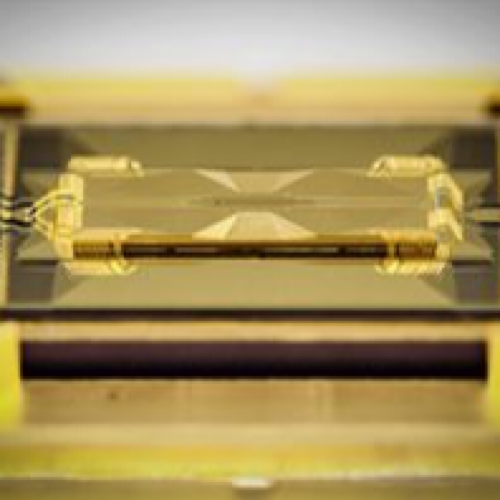Maryland-based IonQ has unveiled a new kind of chip in its quest to scale up its type of quantum computer technology. Its computers calculate using the quantum states of ions electromagnetically trapped in the space near a chip. Previous traps were made using silicon chipmaking processes, but the company has now switched to an evaporated glass trap technology—a way of constructing micrometer-scale features in fused silica glass often used to make microfluidic chips. Its previous trap technology, the company says, could not have supported IonQ’s new quantum architecture, which is based on multiple chains of ion-based qubits. Ultimately, IonQ executives say, the glass chip’s reconfigurable chains of ions will allow for computers with qubits that number in the triple digits.
“The purpose of an ion trap is to move ions around with precision, hold them in the environment, and get out of the way of the quantum operation,” explains Jason Amini, who led the evaporated glass trap team at IonQ. The 3D glass and metal structure Amini’s team constructed does all three better than its previous chips could, Amini says. Stray electric fields from charge on the silicon-based chip could destabilize the ions’ delicate quantum states, reducing the fidelity of quantum computation. But the evaporated glass design “hides any material that could hold charge,” he says. The effect is a more stable trap that computes better..
Another advantage, Amini says, is that the trap could be shaped to “get out of the way” of quantum operations. In an ion trap computer the ions’ quantum states are manipulated by zapping them with lasers. “We have to bring a lot of laser beams over the surface,” says Amini. The glass chip is “shaped to allow lasers to come through and address the device.”
IonQ previously had silicon ion traps constructed at Sandia National Laboratoryin New Mexico. But IonQ wanted more control over the technology and the ability to iterate designs faster, says CEO Peter Chapman.
With the evaporated glass ion trap in hand, IonQ proceeded with a demonstration of their new quantum computing scheme, which Chapman calls the industry’s first “reconfigurable multicore quantum architecture”, or RMQA. But don’t look for too many parallels between field programmable gate arrays and multicore CPUs.
In IonQ’s demonstration it works like this: The trap holds four separate chains of 16 ions in a line. Each chain can be moved into position to be manipulated by the lasers, altering their quantum state or entangling groups of ions so their quantum states are linked. “Each chain is, by itself, a quantum computer,” says Chapman. In addition, two chains can be brought together to form a core that allows entangling qubits across the chains (the reconfiguration part) until eventually all the qubits can be linked to perform big, complex quantum operations.
It’s not perfect, of course. Out of 16 ions, the technology produces 12 qubits, Chapman explains. (The other four are “refrigerant” ions that correct for imperfections during ion transport.) So IonQ’s latest demonstration produce 48 qubits. But it is easily expanded by lengthening the trap. And, because this is quantum computing, a little expansion goes a long way, adding substantially more capability with each added qubit.
“The architecture allows you to relatively easily expand to hundreds of qubits on a single chip,” says Chapman.
The next big leap will come from photonic interconnects IonQ is developing to link qubits on one chip to those on another. “Once you do entanglement, distance no longer matters,” says Chapman. “Whether or not it’s multiple chains on a chip or one chip to another, it all acts as if it’s one big quantum computer.”
source: spectrum










